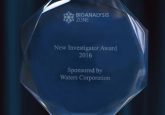2016 New Investigator: Daniel Wilffert

 Nominee:
Nominee:
Nominated By:
Supporting Comments:
What made you choose a career in bioanalysis?
I chose a career in bioanalysis because I like doing research and challenging myself with a large variety of method development questions for the analysis of either small drug compounds or large molecules, like proteins. I especially enjoy the puzzle of finding the optimal sample preparation; selecting the proper analysis techniques and validating them according to the global guidelines. However, what I like most about the field of bioanalysis is the contribution I can finally make to the development or improvement of new drugs and to see them reach the market.
Describe the main highlights of your bioanalytical research, and its importance to the bioanalytical community.
The contribution we made to the bioanalytical community during my PhD at the University of Groningen is the development of highly sensitive LC-MS/MS assays for protein quantification in biological matrices without the use of antibodies. These generic sample preparation approaches have the advantage of avoiding some of the problematic aspects that may arise when using antibodies. Antibodies can be time-consuming and costly to produce and it is sometimes difficult to maintain the same quality from batch to batch. This has led to problems with the reproducibility of a number of commercially produced immunoassays and, consequently, to poor inter-laboratory comparability.
The number of approved protein-based biopharmaceuticals entering the market has increased considerably over recent years. This puts pressure on rapid method development and increases the demand for more generic approaches, like antibody-free LC-MS/MS methods. While pM detection of proteins in complex biological samples has long been the realm of immunoassays, my PhD thesis ‘Antibody-free LC-MS/MS protein analysis of TRAIL’ showed that antibody-free LC-MS/MS approaches start to reach detection at the same concentration range.
What is the impact of your work beyond your home laboratory?
I am currently continuing my work in developing generic antibody-free LC-MS/MS methods, at QPS. For example, we are developing antibody-free LC-MS/MS approaches for the quantification of antibody-drug conjugates ADCs. The generic sample preparation gives a certain flexibility in engineering the antibody that is conjugated to the payload or the drug itself, with a minimal need for additional method development. Moreover, there is no need for raising new antibodies, which could especially be of interest in early preclinical research. The LC-MS/MS analysis gives the possibility for multiplexing and analyzing the intact ADC together with its metabolites, like the free antibody and the free drug.
Describe the most difficult challenge you have encountered in the laboratory and how you overcame it.
The most difficult challenge during my PhD research was to finally analyze the cytokine sTRAIL at pM level without the use of antibodies. We overcame the challenge by focusing on the physicochemical properties of the protein sTRAIL and its signature peptides. The sample preparation was extended with a second SPE enrichment step to improve the clean-up to the max and downscaling to µLC-MS/MS was necessary. A proper surrogate matrix was not available, since even dog saliva showed a sensitivity different from human saliva (slope of the calibration curve). This is the reason we used and validated a standard addition approach for the quantification of sTRAIL.
Describe your role in bioanalytical communities/groups.
Currently I am not involved in a bioanalytical focus group or interdisciplinary group, but I would very much like to join one. I am especially interested in groups focusing on developing new methodologies for bioanalysis of proteins and large molecules. Besides development, I am also interested in the GLP and validation aspects for bioanalysis of proteins and large molecules. I am, for example, interested in how to handle and incorporate qualifier peptides into your validation of your LC-MS/MS analysis of proteins, beside your quantifier signature peptide. This has not yet been described in detail in global guidelines for validation.
Please list up to five of your publications in the field of bioanalysis:
- Wilffert D, Donzelli R, Asselman A et al. Quantitative antibody-free LC-MS/MS analysis of sTRAIL in sputum and saliva at the sub-ng/mL level. J. Chromatogr. B (2016) (In press).
- Wilffert D, Asselman A, Donzelli R et al. Highly sensitive antibody-free µLC-MS/MS quantification of rhTRAIL in serum. Bioanalysis doi:10.4155/bio.16.30 (2016) (Epub ahead of print).
- Wilffert D, Bischoff R, van de Merbel NC. Antibody-free workflows for protein quantification by LC-MS/MS. Bioanalysis 7(6), 763–779 (2015).
- Percy AJ, Tamura-Wells J, Albar JP et al. Inter-laboratory evaluation of instrument platforms and experimental workflows for quantitative accuracy and reproducibility assessment. EuPA Open Proteomics 8, 6–15 (2015).
- Wilffert D, Reis CR, Hermans J et al. Antibody-free LC-MS/MS quantification of rhTRAIL in human and mouse serum. Anal. Chem. 85(22), 10754–60 (2013).
Please select one publication from above that best highlights your career to date in the field of bioanalysis and provide an explanation for your choice.
If I had to select a publication that best highlights my career, it would be our review ‘Antibody-free workflows for protein quantification by LC-MS/MS’. It shows the broad range of possibilities and the rather generic nature of antibody-free workflows for protein enrichment. I expect that the use of such methods will increase in the future as we continue to learn more about how to design and optimize them for a wider range of proteins and peptides. While antibody-based approaches are here to stay, I believe that antibody-free workflows will become more and more important.
Find out more about this year’s New Investigator Award, the prize, the judging panel and the rest of our nominees.




